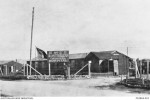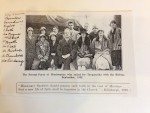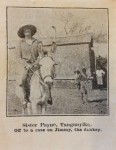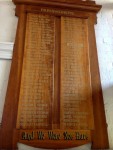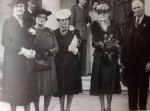PAYNE, Violet Minnie
Violet Payne
Violet and her twin sister Lily both served in the Australian Army Nursing Service during the Great War. (Twins serving were not unknown; twins Catherine and Amelia Uren of SA also joined the AANS). They enlisted and embarked separately and served in different theatres of war but returned to Australia in 1919 on the same ship.
Their lives diverged after the war. Lily married and Violet resumed nursing. Violent moved into the new field of infant and child welfare. That decision led her to Tanganyika (now Tanzania) where she worked as a missionary for nearly two decades before returning permanently to Australia in 1946. She lived with and cared for Lily, an invalid, for the last years of Lily’s life, each of them in reduced circumstances.
Violet died aged almost 89 on 14 January 1969.
They were the aunts of Australia’s legendary war hero, Sir Edward (‘Weary’) Dunlop and played a significant role in his upbringing.
***
Violet and Lily Payne were the twin daughters of Edward Samuel Payne (1827–1897) and his wife Catherine (nee Walpole) (1840–1922).
Edward had been born in England in 1827 and come to Van Diemen’s Land (Tasmania) with his mother and younger siblings in 1842. They came to join husband and father Edward Payne, a ship’s captain who had regularly carried passengers and cargo between Britain and the Antipodean colonies on the bark ‘Fortitude’. Ashore in Hobart Town in 1841, Payne had purchased the bark ‘Royal William’ which plied the waters primarily between the eastern colonies and New Zealand (Courier [Hobart], 15.12.1840, 2.3.1841, 4.2.1842).
The family settled in Hobart Town, but their lives were disrupted in 1851 when Payne was killed by a gun that discharged accidentally in his cabin during bad weather when the ‘Royal William’ was off the Tasman Peninsula (Courier, 19.3.1851). Mrs Payne and at least some of her children (aged from about 10 to 24) moved to Victoria in the early 1850s. There are no records of the family until the early 1860s, when Edward Samuel Payne, timber splitter, applied for land from the Ballarat Land Commission.
If Edward’s family story had a sad and romantic tinge, so did that of his wife Catherine. Considerable detail had been captured by Sue Ebury in her extensive research into Australian war hero Edward ‘Weary’ Dunlop, Catherine’s grandson (Sue Ebury, Weary: The Life of Sir Edward Dunlop, 1994; the information here is from Ebury and the records of the Honourable East India Company). She was born in 1840 in India. Her father, Henry Nagle Walpole (1810–89) was born to schoolmaster George Walpole and his wife Catherine (nee Cade) in Kent, England. Henry would later claim medical and surgical postings with the East India Company after training in England. However in 1836, according to his marriage certificate, he was the schoolmaster sergeant attached to the 2nd Artillery Battalion of the Madras Army run by the East India Company. He instructed the children of non-commissioned officers and soldiers and possibly soldiers as well.
Walpole’s personal life was complex. East India Company records show that in 1836, he married the not quite 15 year old Sophie Matilda Bathe (b 1821) in St Thomas Mount garrison church in Madras (Chennai). One of the three witnesses was M (Maria) A (Angelina) Jackson. Maria was the second wife and widow of Sophie’s father William Bathe and subsequently the widow of William Jackson. Less than a year after his marriage to Sophie, Walpole fathered a son born to Marie Jackson, Thomas Richard Walpole. Thomas was born and baptised in Moulmein, then the capital of British Burma, suggesting that Henry had been transferred well away from Madras. The fate of his wife Sophie Walpole is unclear.
Marie and Henry had another child, Catherine Maria (later to be Violet and Lily Payne’s mother), who was born in Dum Dum near Calcutta (Kolkatta) in 1840. Henry was described as a ‘gunner of artillery’.
Henry and his family arrived in Victoria in 1855 (Ebury, Weary: The Life of Sir Edward Dunlop, p7). His brother, the Rev Joseph Kidd Walpole, had been a clergyman in New South Wales in the 1840s but had returned to England by then; (http://anglicanhistory.org/aus/cci/). Henry’s obituary (Argus, 1.10.1889, p10) described him as a ‘highly educated medical man [who] had seen much service in Burmah, Madras and Central India’, who had turned down medical appointments and who, foreseeing unrest, had left India before the ‘Sepoy revolt’ (1857). According to Ebury’s account, he came with his children, Thomas and Catherine, third wife, not Maria (of whom there is no record after Catherine’s birth) and their children. He took up mining and farming interests in the Ballarat region. Disaffected by life in 1850s Ballarat, Mrs Walpole returned to India with Henry’s papers and their (own) children (Ebury, Weary: The Life of Sir Edward Dunlop, p7).
An inquest in the Victorian town of Bullarook (near Ballarat) in 1862 adds details. Walpole gave evidence on the death of a child whom he had treated. He described himself as a member of the Royal College of Surgeons and qualified medical practitioner who, because he was not qualified to practise in Victoria, offered assistance only in emergencies (Creswick and Clunes Advertiser, 24.1.1862). His health, he said, had been severely affected for twenty years by sunstroke, and he was currently ‘very ill’. He was reprimanded for providing treatment when not legally qualified to do so.
Walpole made a number of purchases from the Ballarat Land Commission, sometimes in conjunction with his son Thomas (e.g. Ballarat Star, 18.9.1866, p4). He raised funds in England (probably through his brother, Joseph Kidd Walpole, a clergyman) for the proposed Church of England in Bungaree. His son Thomas was persuaded to start a school in connection with the church, and became a third Walpole generation teacher as a result (http://www.bungareehistorywalk.com/feedback-blog/first-post). Catherine, his daughter, was multilingual, read Latin and painted (Ebury, Weary: The Life of Sir Edward Dunlop, p7).
In 1866, Catherine married Edward Samuel Payne, who were to be the parents of Lily and Violet. She married against her father’s wishes: Payne was a timber splitter, eking out an income on the edge of the Bullarook forest near Bungaree and purchasing small parcels of land (Ebury, Weary: The Life of Sir Edward Dunlop, p7). Their first four children were born in or near Bungaree between 1867 and 1872. The family moved north to Dookie and then Shepparton where the remaining five children were born between 1874 and 1882, including twins Lily and Violet in 1880. They then moved north east to Whorouly near Oxley, where Henry, Thomas and probably members of Edward’s family had also moved. Family members steadily acquired more land, becoming substantial holders and graziers in the area (e.g. Ovens and Murray Advertiser 13.2.1886, p 11). Thomas, Henry’s son, was also the head teacher at Everton State School near Wangaratta.
Lily Mary and Violet Minnie were twins born to Edward and Catherine Payne in 1880, the couple’s seventh and eighth children. They were educated privately at home, probably by their erudite mother, and then at the Whorouly South Primary School (Payne, Violet, CMS Missionary, SLV MS 13606).
Nursing was not Violet’s first profession. In her twenties, she trained as a teacher – the fourth generation of teachers in her family – and taught in government schools in Western Australia. She returned to Victoria and began three years training as a nurse at the Children’s Hospital in Carlton in 1910. Various factors may have influenced her: the death of two siblings in adulthood from typhoid and the death of her father from appendicitis, the example of her elder sister Catherine who had trained at the Wangaratta Hospital in the early 1900s, and /or the experience with twin Lily of bringing up the young son of her sister Alice (Edward Dunlop) during Alice’s ill-health (Ebury, Weary: The Life of Sir Edward Dunlop, p12). Other contributing factors may have been a desire for independence from her strong-willed mother (Ebury, Weary: The Life of Sir Edward Dunlop, p7-8) and the growing religious convictions that prompted her to be baptised at the age of 31 at St Peter’s Eastern Hill Church in East Melbourne.
After Violet finished training, like twin Lily and sister Catherine she registered her name for nursing positions with Elmore, the trained nurses home at 1101 Hoddle St, East Melbourne. All were on the books of St Peter’s Eastern Hill Church as parishioners and members of the St Barnabas Guild for Nurses. She nursed in private homes (a common practice), and was sister in charge of Dr Kent Hughes’ surgery and hospital in Collins St, Melbourne in 1914-15. In 1915, she and Lily took over the running of the successful St Alban’s Private Hospital in Wangaratta (Wangaratta Chronicle, 25.9.1915, p2).
War Service
In August 1916, Violet joined the Australian Army Nursing Service and worked her required period of home service at No 5 Australian Infectious Diseases Hospital at Glenroy (Violet Payne, Service Record, National Australian Archives).
Violet was the second member of her immediate family to enlist. Her younger brother Alfred had enlisted earlier in the year and embarked for overseas on 3 June. Private Payne was to have an eventful war: wounded in action three times, hospitalised for weeks with influenza/bronchitis, and sentenced to field punishment (including hard labour and loss of pay) on two occasions for refusing to obey orders. After his second serious wounding in mid 1917 he was anxious to return home (Wangaratta Chronicle, 29.9.1917, p4).
A bout of measles delayed Violet’s departure overseas, but she embarked on the Orsova in late 1916 and disembarked in England on the eve of her 37th birthday on 19 February 1917 (Wangaratta Chronicle, 1.10.16, p3; Violet Payne, Service Record). A fortnight later, she was working at 1 Australian General Hospital situated with several large British hospitals on the racecourse at Rouen, France.
1AGH treated British, Australian and allied battle casualties. The unit’s war diaries stark entries (mainly statistics) show the situation in the three months Payne was there. The hospital’s capacity grew from 800 to 1040, and the number of nurses expanded from 62 at the beginning of March 1917 to 85 in May. Nearly a quarter of the patients were wounded by gun shot, shrapnel and artillery fire, but the majority were sick with respiratory and other illnesses, partly the result of the notorious Somme winter of 1916-17. While there was a continuous flow of admissions and discharges (usually transfer to England), patients stayed on average 7 or 8 days in the hospital.
After three months at 1AGH, Payne was transferred to 17 Casualty Clearing Station at Remy Siding near Ypres. CCS were much closer to the lines than general hospitals and the nursing was inherently more dangerous because of air raids and bombings. Much of the work involved preparing seriously wounded and sick troops for transport by train and other means to the general hospitals. Payne spent 3 months at 17 CCS at Remy Siding from June till late August. Casualties poured in from the Battle of Messines in June; Payne and her colleagues were run off their feet.
Violet’s letter home published in local newspapers convey something of her experiences. In a ‘scrappy note’ she contrasted long hours and ‘very sad and awful’ sights with her happiness at being a ‘help and comfort to these poor suffering boys’ (Wangaratta Chronicle, 29.9.17, p4). In another letter she described the ‘music’ – the noise of the guns, the vivid explosions in the sky, and the ‘awful fascination’ of it (Wangaratta Chronicle, 29.9.17, p3). The last week of her duty at 17 CCS was ‘very lively’. Mindful of the censor’s eye and her family’s anxiety, she wrote:
Fritz came over every night, and one night dropped several bombs, doing a little damage, so after that we had to resort to dugouts .., Shrapnel was showering down everywhere and all over our tents ... we escaped without a scratch (Benalla Standard, 27.11.17, p3)
In fact as the war diary of the adjacent 2 Canadian CCS recorded, 17 CCS was hit. The bombs left with several large craters very close to huts and tents and 60 personnel and German POWs were killed o injured (http://1914-1918.invisionzone.com/forums/index.php?showtopic=79098). The Matron-in-Chief of the British Expeditionary Force visiting the area at the time noted how well the patients at 17CCS were nursed and how well the hospital (which included ‘6 American Nursing Sisters and a lady Anaesthetist’) continued to function (http://www.scarletfinders.co.uk/71.html).
Violet Payne spent the last four months of 1917 at 2 Australian General Hospital at Wimereux. It was far less hectic than the CCS, with a day off a week and three hours off each day when the work load permitted. Work and relaxation were not hampered by blackouts. Socializing with Australian officers and men from the nearby rest camp was allowed. She recounted a ‘very nice party’ for around 60 officers, with ‘music, singing, dancing and supper’, an occasion to be repeated the following night for privates and NCOs (Benalla Standard, 27.11.17, p3; Wangaratta Chronicle, 17.11.1917, p3; Wangaratta Chronicle, 13.4.1918, p3). The hospital was very busy with serious cases in October and November, many of them surgical, but by December the situation had eased and medical cases predominated (2AGH, Unit War Diary, Oct-Dec 1917 [AWM]).
In early 1918, 2AGH reduced its bed capacity and Violet Payne returned to 1 AGH on the Rouen race course where she spent the remainder of the war. It was, she said, ‘not such an up-to-date hospital as No 2 [AGH]’ but she was delighted to encounter friends from her training days at the Children’s Hospital (Wangaratta Chronicle, 13.4.1918, p3).
Payne’s experience in 17 CCS equipped her well for 1AGH which throughout 1918 often operated in practice as a casualty cleaning station. At times patient numbers exceeded 1300 amid a continuous and taxing churn of admissions, treatment and evacuations. Many patients were seriously wounded with bullet and blast injuries, and/or gas poisoning. The operating theatres were regularly in use well into the night. Air raids in the area were not uncommon.
In June 1918, Payne may have had an opportunity to meet her brother, Alfred. He was hospitalised for several days elsewhere in Rouen while awaiting evacuation to England for treatment for a gunshot wound to his knee – his third and final wounding in action (Albert Payne, Service Record).
Payne was one of around 100 nursing sisters at 1AGH. The nurses’ living conditions fluctuated. The early months of 1918 were bitterly cold and some nurses were housed in tents with limited heating and hot water. When the situation was remedied in mid 1918 (summer), Matron Gray welcomed the installation of hot water in the nurses’ bathrooms. It was not about personal comfort she emphasized but a matter of professional effectiveness: ‘one feels that the way the staff has kept up during the incessant rush of patients in the last few weeks is largely due to the comfort of these hot baths’ (1AGH, War Diary, September 1918).
The nurses’ health and signs of strain were monitored by Matron Gray. Amid fluctuating and unpredictable circumstances she arranged convalescent and recreation leave and as a last resort transfers to England when appropriate. After a period on night duty, Violet Payne went to Paris on leave. For six days, she and other nurses enjoyed the sights and sounds of Paris, fussed over and escorted everywhere by some of ‘our dear Aussie boys’ (Benalla Standard, 28.6.1918, p3). The war could not be escaped however even on leave, and Paris was shelled while she was there. Military operations then cut short her leave: Payne’s group was ‘recalled at the double ... [we] have been working at top speed ever since’ (Benalla Standard, 28.6.1918, p3).
The matron’s report bore this out. ‘The stress of work has been more continuous than for some time’ she wrote in her report for September. The pressure did not let up. The work in October was ‘very great’, with admissions and deaths at record levels. With the signing of the Armistice on 11 November, wounded patients were replaced with patients suffering from influenza and the high mortality rate continued. Many of the nurses also contracted influenza.
In December, patient numbers began to drop and 1AGH was ordered to relocate to England. Throughout December, patients were evacuated, wards were closed and equipment packed.
Violet Payne was in the first group of 1AGH nurses to be transferred to England on 17 December, with orders to report to 1AGH at its new location at Sutton Veny in Wiltshire. She was promoted from staff nurse to sister on 29 December 1918. Presumably she was able to make contact with her brother Albert, awaiting his return to Australia in the convalescent depot in Weymouth.
Payne had been on active service on the Western Front for almost two years. During that time, her service record noted only one bout of ill health with a week of hospitalization in November 1918, due to an injured (infected?) finger.
After the War
Violet Payne and her sister Lily returned to Australia from their different theatres of war in 1919 on the same ship, the ‘Wiltshire’. Identical twins, they played tricks on the officers as each pretended to be the other (Butler, Janet. ‘Gone to War as Sister.’ Speech at the Opening, East Melbourne Historical Society Exhibition, 'Gone to War as Sister: East Melbourne Nurses in the Great War', East Melbourne Library, 19 August 2015). They reached Australia on 19 August 1919. Violet was discharged from the AANS on 15 November 1919.
Lily married in 1920, leaving Violet as the only single sister. Violet had already taken up the duty of caring for their bedridden mother, replacing the nurse paid throughout the war (Payne, Violet, Application File, Edith Cavell Trust Fund, M290 NAA). Unable to earn an income, she sought assistance from the Edith Cavell Trust which supported sick and needy Victorian army nurses. She was granted £10 on two occasions – for income assistance in early 1920 and for funds for a respite rest in 1921.
Violet nursed her mother for four years, from her return from the war till her mother died in 1923. Her own health was ‘very indifferent’, both from nursing her mother and then from a severe septic infection which hospitalised her for weeks and resulted in an amputated finger. The Trust granted her £15 to assist with hospital fees and lost income.
Violet Payne then moved into the burgeoning field of infant welfare, in common with a number of Great War nurses. Violet’s close friend from St Peter’s Eastern Hill, Sister Annie Purcell, was a leading figure in Victoria’s baby health/infant welfare field and may well have influenced Violet to take this direction.
It proved a life-changing decision.
In 1926, Violet was appointed inspector of infant welfare in Ballarat. A regular churchgoer, she was so moved by a sermon on missionary work in Tanganyika (Tanzania) that she immediately contacted the Church Missionary Society and volunteered to be a missionary nurse (Payne, Violet, CMS Missionary, SLV MS 13606). Her high Anglican spirituality perturbed officials of the evangelical CMS, as did her age and lack of midwifery certification. However, her extensive nursing experience, good health and obvious commitment seemed to bode well for the life of a missionary nurse in the tropics and she was accepted. After bible training and induction, Violet embarked for overseas again in 1928, this time with a group of missionaries for Tanganyika. The Edith Cavell Trust granted her £15 during her missionary training at the Melbourne Bible Institute.
Violet was ideally suited to the expansion of CMS medical work in Tanganyika in the late 1920s. CMS hospitals treated all manner of illnesses and conditions, including thousands of leprosy cases, and ran child welfare centres in connection with them. Under the guidance of sisters like Payne, African women trained as nurses and matrons who in turn instructed local women in safe healthy child rearing practices.
Payne worked with the famous ‘jungle doctor’ Paul White during his brief period in Tanganyika (1939–41) and was a member of his team credited with significantly reducing infant mortality in villages and rural areas (e.g. Australian Women’s Weekly, 18.10.1941, p2). White’s engaging ‘jungle doctor’ books for children and radio programs familiarised many Australians with their work – Payne could easily have been one of the ‘white Sisters’ in his stories.
Payne served in various mission stations including Buigiri, Kilimatinde and Berega. She learnt Swahili (she had deliberately learnt French before joining the AANS) and studied for her midwifery certificate while on furlough in Melbourne in 1933. Her furlough in Melbourne in 1939 was prolonged by the war but she finally returned to the busy hospital in Berega. While on leave and later in retirement, she spoke publicly on the work in Tanganyika. She was regarded as an engaging deputationist who brought to life the work she and other CMS missionaries undertook.
There was strong connection in Payne’s mind between her nursing service in the Great War and in Tanganyika, namely her religious convictions. In her CMS application, she explained she had long felt called to missionary work: 'I feel it is the same spirit that made me volunteer for service as a nurse in the World War, although I could have done work at home.' Before the war she had been confirmed and joined the nurses' guild at St Peter's Eastern Hill, where she was befriended by Annie Purcell who also served in the AANS. Whether her patients were the ‘poor suffering boys’ on the Western Front or 'heathen women folk' in Africa, in her work as a nurse she pledged herself to 'teach them in a practical way the meaning of the work done by the followers of Christ' (Payne, CMS Application, SLV MS13606).
After 18 years in Tanganyika and with her health depleted by diabetes and other conditions, in 1946 Payne (now 66) retired and left Tanganyika for the last time. The CMS took a keen interest in its retired missionaries and she may have participated in its summer schools and deputation work on her return to Melbourne.
After recuperation and rest (with another small grant from the Edith Cavell Trust), Violet resumed nursing, intermittently at least. She may have assisted her sister Lily run her convalescent home. However, by 1949, Violet was unable to work because of deteriorating health – her own and her sister’s – and the responsibility of managing their household. Over the next few years, she made regular and successful pleas for assistance to the Edith Cavell Trust, each application detailing growing health and financial burdens. In 1957, her sister died and a Repatriation Department pension provide some relief but she had no funds to maintain the house her sister left her. Further grants came from the Trust, the last in 1964. By then, Violet Payne was in ‘necessitous circumstances’, living in a room in Melbourne’s Elsternwick with her health continuing to deteriorate.
She died on 14 January 1969 in Heidelberg Hospital, Melbourne, aged almost 89, and was cremated at Springvale Cemetery.
Violet Payne had nursed continuously for nearly 50 years: children in Melbourne, sick and wounded soldiers in Egypt and on the Western Front, then her bedridden mother in country Victoria, mothers and babies in Tanganyika (Tanzania), and finally the twin sister who like her had served in the Australian Army Nursing Service. She lived, served and died in relative obscurity, unlike her celebrated nephew, war hero Edward ‘Weary’ Dunlop.
Thanks to Rob Dunlop for drawing my attention to the connection with Edward 'Weary' Dunlop.
Janet Scarfe
Adjunct Research Associate, Monash
Updated 15 January 2016

